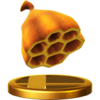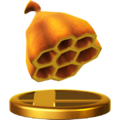Wasp nest
Wasp nests (known as beehives prior to Animal Crossing: New Horizons) are items in the Animal Crossing series that can be found in the town's trees, which it can be shaken out of. Upon making contact with the ground, the wasp nest spawns a Wasp swarm that chases the player before disappearing. The swarm continues its pursuit until the player gets stung (resulting in a swollen left eye), enters a building, saves and quits, uses a Party Popper in New Horizons, or catches the bug with their net.
Appearances[edit]
In Animal Crossing[edit]
Beehives first appear in Doubutsu no Mori and its GameCube port, Animal Crossing, randomly dropping out of shaking trees. In this game, only five appear per day, with one beehive spawning per acre. When one drops, a swarm of Bees will immediately chase after the player after they display a shocked expression at the sight. The player can only escape them by catching them in a net, or entering a building. After the swarm appears, the beehive itself vanishes.
In Animal Crossing: Wild World and Animal Crossing: City Folk[edit]
The beehive serves the same purpose in Animal Crossing: Wild World and Animal Crossing: City Folk as it did in Animal Crossing. Additionally, none will appear when the town gate is open for visitors.
In Animal Crossing: New Leaf[edit]
In Animal Crossing: New Leaf, beehives are now an item that can be picked up, and they can be sold for 500 Bells at Re-Tail or be used in a recipe for the Harvest Festival as a secret ingredient for the Fruit Salad or most of the pies. None will appear when the town gate is open for visitors.
In Animal Crossing: New Horizons[edit]
In Animal Crossing: New Horizons, wasp nests can be sold at Nook's Cranny for 300 Bells. Additionally, they can be used in various DIY recipes.
In Animal Crossing: amiibo Festival[edit]
The Desert Island Escape minigame present in Animal Crossing: amiibo Festival and Animal Crossing: New Leaf - Welcome amiibo includes the beehive as a food supply that the player can obtain after fighting Bees.
Other appearances[edit]
Super Smash Bros. series[edit]
Beehives appear as throwable items in Super Smash Bros. for Nintendo 3DS / Wii U and Super Smash Bros. Ultimate. When the hive is thrown, a bee swarm will spawn and attack the opponent who is hit. However, if the beehive fails to make contact with an opponent, the thrower will be attacked instead. Each sting deals 2 to 4 percentage points of damage, and the bees remain on the stage for 10 seconds, chasing their target wherever they go (similar to how they act in the "Animal Crossing series" of games). In addition, on variations of the Tortimer Island stage where there are trees, a beehive can occasionally be found, though it is invisible to players until the tree holding the hive is struck.
| Description | NTSC-U: An example of fine architecture constructed by insects, these bees are not shy about defending their hard work. Throw this at an enemy to direct their hate at that player. If the bees are after you, you can shake them for a while with some evasive maneuvers, but they'll track you down. PAL: Bees don't like it when people destroy their home, so if you break a beehive, they'll come out looking for revenge. Even if you innocently had the beehive thrown at you, you'll be the target. You can dodge all you want, but they'll probably get you in the end, and their stings'll do a LOT of damage. | |
|---|---|---|
| Acquisition | Random | |
Gallery[edit]
Icon in New Leaf
Trophy in Super Smash Bros. for Wii U
Names in other languages[edit]
| ハチのす Hachi no su |
Beehives | |
| 벌집 beoljib |
Honeycomb | |
| 蜂巢 Fēngcháo |
Honeycomb | |
| 蜂巢 Unknown |
||
| осиное гнездо osinoye gnezdo |
vespiary | |
| wespennest | ||
| Honigwabe (before New Horizons) Wespennest (since New Horizons) |
||
| panal (before New Horizons) avispero (since New Horizons) |
||
| rayon de miel (before New Horizons) nid de guêpes (since New Horizons) |
||
| alveare (before New Horizons) vespaio (since New Horizons) |
||
| ||||||||||||||


